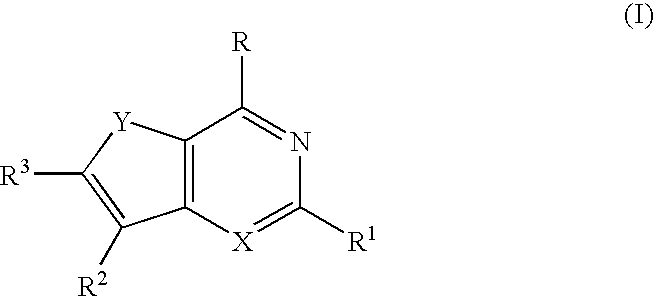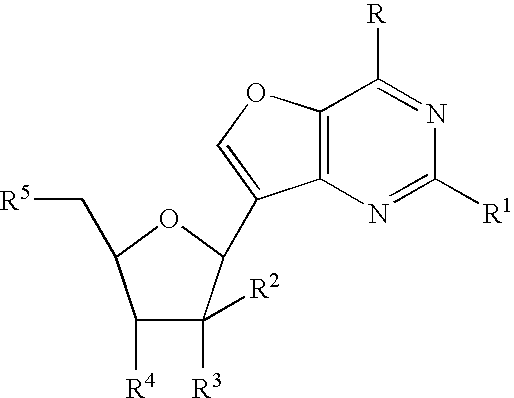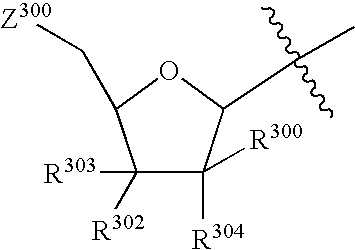Hepatitis C therapies
a technology of hepatitis c and c therapy, applied in the field of hepatitis c therapies, can solve the problems of causing anemia, causing death and economic loss, and ribavirin alone is not effective in reducing viral rna levels,
- Summary
- Abstract
- Description
- Claims
- Application Information
AI Technical Summary
Benefits of technology
Problems solved by technology
Method used
Image
Examples
example a-1
[0244]
2-(3,4-Bis(benzyloxy)-5-(benzyloxymethyl)-tetrahydrofuran-2-yl)acetonitrile (Scheme A-1)
[0245]Step 1: To a solution of D-ribose (61 g, 406.66 mmol) in methanol (1 L) was added conc. sulfuric acid (6.1 mL) and stirred at 4° C. for 16 h. The reaction mixture was neutralized using triethylamine (40 mL), concentrated to dryness and co-distilled twice with 200 mL of toluene to remove trace amount of water. This furnished 72 g of crude O-methyl-D-ribofuranose, which was used as such for next step.
[0246]Step 2: To a slurry of NaH (65 g, 60%, 1.626 mol) in DMF (200 mL) was added crude compound from Step 1 (72 g, 406.66 mmol) in DMF (800 mL) over a period of 0.5 h, maintaining the temperature below 5° C. The anion formed was stirred at room temperature for 30 min. Benzyl bromide (219.1 g, 1280.9 mmol) was added dropwise over a period of 1 h maintaining temperature between 0-5° C. The reaction was stirred at room temperature for 12 h (TLC analysis in 30% ethyl acetate / hexane showed comp...
example b-1
[0249]
7-β-(2′,3′,5′-Tri-O-benzyl-D-ribofuranosyl)-furo[3,2-d]pyrimidin-4(3H)-one (Scheme B-1)
[0250]Step 1: To a stirred solution of compound from Step 4 of example A-1, (3S,4R,5R)-(3,4-bis-benzyloxy-5-benzyloxymethyl-tetrahydro-furan-2-yl)-acetonitrile (10.7 g, 24.12 mmol) in DMF (150 mL) was added tert-butoxybis(dimethylamino)methane (21.02 g, 120.62 mmol) at room temperature and stirred for 12 h. The reaction mixture was diluted with toluene (700 mL) and washed with water (2×250 mL), brine (1×50 mL) and dried (MgSO4). After filtration, the filtrate was concentrated to give (13.8 g) of desired product, which was used as such for next step.
[0251]Step 2: The compound from Step 1 (13.8 g, 24.12 mmol) was dissolved in chloroform (250 mL), trifluoroacetic acid (4.59 g, 40.29 mmol) and water (137 mL) at room temperature and stirred for 18 h. The organic layer was separated and the aqueous layer was extracted with chloroform (2×200 mL). The combined organic extracts were washed with water...
example b-2
[0255]
4-Chloro-7-β-(2′,3′,5′-tri-O-benzyl-D-ribofuranosyl)-furo[3,2-d]pyrimidine (Scheme B-2)
[0256]To a stirred solution of compound from Example B-1, Step 5, (6.26 g, 11.62 mmol), benzyltriethylammonium chloride (5.29 g, 23.24 mmol), N,N-dimethylaniline (2.12 g, 17.43 mmol) in acetonitrile (50 mL) was added phosphorous oxychloride (10.69 g, 69.74 mmol) at 80° C. and further stirred at 80° C. for 30 min. Then the reaction was concentrated to dryness, dissolved in chloroform (100 mL) and quenched with water (50 mL). The organic layer was separated and aqueous layer was further extracted with chloroform (2×50 mL). The combined chloroform extracts were washed with water (2×100 mL), sat. NaHCO3 (1×50 mL), water (1×100 mL), and brine (1×50 mL), and dried (MgSO4). After filtration, the filtrate was concentrated and the residue was purified by flash chromatography on silica gel column using ethyl acetate in hexanes (0 to 25%) to afford 5.62 g (86.8%) of desired product as a colorless cryst...
PUM
| Property | Measurement | Unit |
|---|---|---|
| body weight | aaaaa | aaaaa |
| temperature | aaaaa | aaaaa |
| temperature | aaaaa | aaaaa |
Abstract
Description
Claims
Application Information
 Login to View More
Login to View More - R&D
- Intellectual Property
- Life Sciences
- Materials
- Tech Scout
- Unparalleled Data Quality
- Higher Quality Content
- 60% Fewer Hallucinations
Browse by: Latest US Patents, China's latest patents, Technical Efficacy Thesaurus, Application Domain, Technology Topic, Popular Technical Reports.
© 2025 PatSnap. All rights reserved.Legal|Privacy policy|Modern Slavery Act Transparency Statement|Sitemap|About US| Contact US: help@patsnap.com



